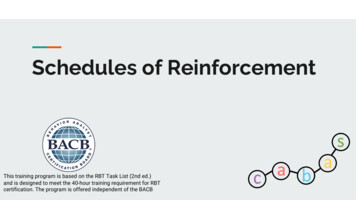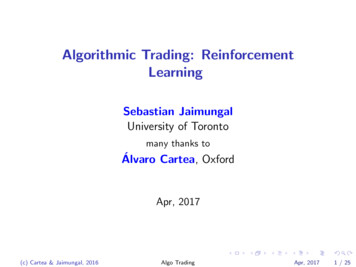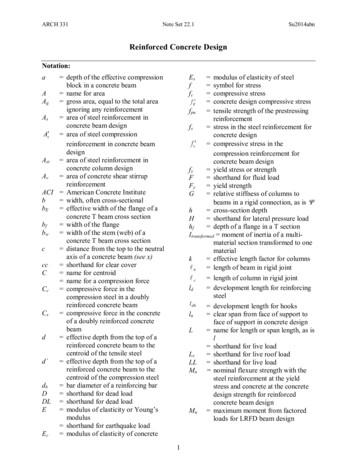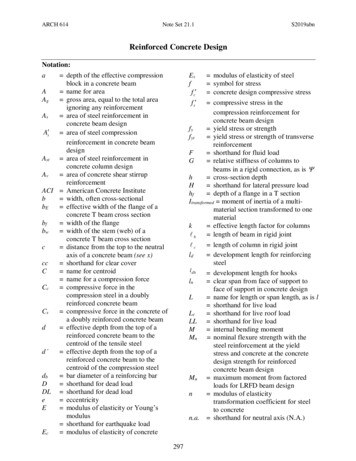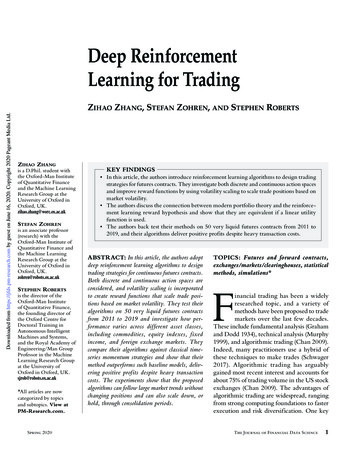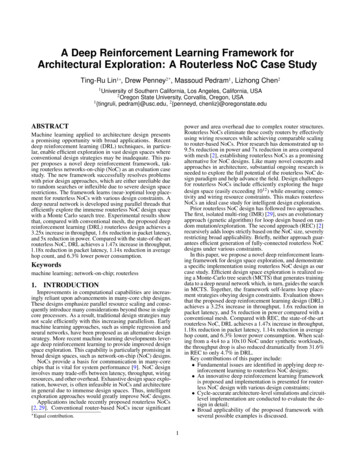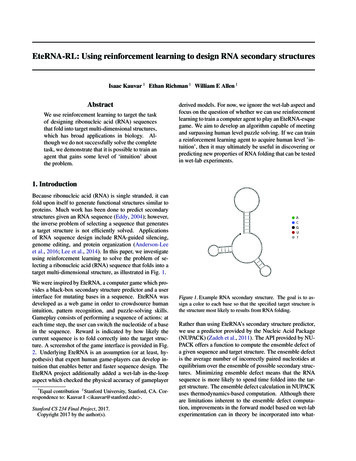
Transcription
EteRNA-RL: Using reinforcement learning to design RNA secondary structuresIsaac Kauvar 1 Ethan Richman 1 William E Allen 1AbstractWe use reinforcement learning to target the taskof designing ribonucleic acid (RNA) sequencesthat fold into target multi-dimensional structures,which has broad applications in biology. Although we do not successfully solve the completetask, we demonstrate that it is possible to train anagent that gains some level of ‘intuition’ aboutthe problem.derived models. For now, we ignore the wet-lab aspect andfocus on the question of whether we can use reinforcementlearning to train a computer agent to play an EteRNA-esquegame. We aim to develop an algorithm capable of meetingand surpassing human level puzzle solving. If we can traina reinforcement learning agent to acquire human level ’intuition’, then it may ultimately be useful in discovering orpredicting new properties of RNA folding that can be testedin wet-lab experiments.1. IntroductionBecause ribonucleic acid (RNA) is single stranded, it canfold upon itself to generate functional structures similar toproteins. Much work has been done to predict secondarystructures given an RNA sequence (Eddy, 2004); however,the inverse problem of selecting a sequence that generatesa target structure is not efficiently solved. Applicationsof RNA sequence design include RNA-guided silencing,genome editing, and protein organization (Anderson-Leeet al., 2016; Lee et al., 2014). In this paper, we investigateusing reinforcement learning to solve the problem of selecting a ribonucleic acid (RNA) sequence that folds into atarget multi-dimensional structure, as illustrated in Fig. 1.We were inspired by EteRNA, a computer game which provides a black-box secondary structure predictor and a userinterface for mutating bases in a sequence. EteRNA wasdeveloped as a web game in order to crowdsource humanintuition, pattern recognition, and puzzle-solving skills.Gameplay consists of performing a sequence of actions: ateach time step, the user can switch the nucleotide of a basein the sequence. Reward is indicated by how likely thecurrent sequence is to fold correctly into the target structure. A screenshot of the game interface is provided in Fig.2. Underlying EteRNA is an assumption (or at least, hypothesis) that expert human game-players can develop intuition that enables better and faster sequence design. TheEteRNA project additionally added a wet-lab in-the-loopaspect which checked the physical accuracy of gameplayer*Equal contribution 1 Stanford University, Stanford, CA. Correspondence to: Kauvar I ikauvar@stanford.edu .Stanford CS 234 Final Project, 2017.Copyright 2017 by the author(s).Figure 1. Example RNA secondary structure. The goal is to assign a color to each base so that the specified target structure isthe structure most likely to results from RNA folding.Rather than using EteRNA’s secondary structure predictor,we use a predictor provided by the Nucleic Acid Package(NUPACK) (Zadeh et al., 2011). The API provided by NUPACK offers a function to compute the ensemble defect ofa given sequence and target structure. The ensemble defectis the average number of incorrectly paired nucleotides atequilibrium over the ensemble of possible secondary structures. Minimizing ensemble defect means that the RNAsequence is more likely to spend time folded into the target structure. The ensemble defect calculation in NUPACKuses thermodynamics-based computation. Although thereare limitations inherent to the ensemble defect computation, improvements in the forward model based on wet-labexperimentation can in theory be incorporated into what-
EteRNA-RLever algorithm we design, simply by modifying the rewardfunction.Because there are four possible nucleotides for each base,the combinatorial number of options for a sequence oflength n is 4n . For n 30, this is 1e18 combinations.For n 100, this is 1e60 combinations. Because of theexponential nature of the problem, it quickly becomes impossible to either enumerate across all possible combinations, or to tabulate the score associated with each combination. Finding the target sequence is made easier by taking a proper sequence of steps - it is sometimes better to bein one state than another state when selecting the next step.Because this game offers a continuously computable score,there are a number of optimization approaches that couldapply. However, because the action space is discrete, andhumans appear to be effective at solving the game by making a sequence of action decisions, reinforcement learningis potentially a good algorithm to apply. Further, gradientbased methods do not necessarily make sense in this setting, and an algorithm, such as a reinforcement learningagent, that can incorporate some intuition about how RNAfolds may perform better than a generic global optimizationalgorithm.One essential question of our investigation is whether reinforcement learning can train an agent to acquire humanlike intuition. Can it learn heuristics that human EteRNAgame-players have learned? One such example is ’boosting’ loops, which is the use of certain nucleotide combinations at the first unpaired positions of a loop.We reiterate that it is not clear to us whether a reinforcement learning based approach will actually work betterthan a generic evolutionary based approach.It is also worth noting that we are essentially generating aframework to solve the general problem of coloring a graphaccording to a black-box function that defines the quality ofthe coloring.2. Methods2.1. Problem setupWe will solve the problem for a fixed-sized graph of n elements, where each node is labeled with a color. The graphrepresents an RNA sequence, where the color of each noderepresents the nucleotide of that base, and the links in thegraph represent which nodes are bonded to one another, asseen in Fig. 3. Even with a fixed size graph as input, wecan use the same learned parameters on graphs of fewer elements by simply labeling the extra nodes with a color indicating that they are to be ignored (i.e. setting their valueto 0).State: (adjacency matrix, color vector), with A {0, 1}n(n 1)/2 and C {0, 1, 2, 3, 4}n . The orderingof the color vector matters, and indicates the sequence ofbases. The adjacency matrix only indicates paired bases,and is vectorized so that the first elements correspond tothe pairing of the first base with other bases.Action: (i, x), indicates change node i to new color x. Weenumerate the possible (i, x) pairs by assigning each one aunique integer identifier. We define the deterministic stateaction transition function to bef (s, a) : set s[i] x {1, 2, 3, 4}(1)Objective: Minimize ensemble defect.Reward: Gain 1 point for decreasing ensemble defect by1. (We will store the ensemble defect of the previous stateand then compute the difference). The sum reward at theend is thus just equivalent to the total improvement in theensemble defect through the episode.StateFunction approximatorQ-functionQ(s, θ)s’ f(s, action)reward ensemble defectFigure 3. Problem setup.Figure 2. Screenshot of EteRNA computer game in which humanscan learn and then utilize intuition about how to produce goodcolorings.Our problem is one with a known and deterministic, thoughnon-differentiable, transition model. The transition model,specifically, is that if the specified action is to change the
EteRNA-RLcolor of a specific node, the game will always change thatcolor with a probability of 1. The reward function, however, is unknown and non-differentiable, but can be simulated with a forward model.2.2. AlgorithmIn this current work, we focus on implementing a valuefunction approximating Deep-Q Network (DQN). Futurework would likely benefit significantly from also exploringthe efficacy of policy gradient approaches. In the resultssection we also compare our RL agent to a generic globaloptimization algorithm that directly optimizes the ensemble defect.We use the DQN algorithm with memory replay presentedin (Mnih et al., 2015). We use temporal difference (TD)learning based gradient updates to approximate the stateaction value function Q. We used stochastic gradient descent with Adam update steps.Algorithm 1 DQNInitialize Q-function parameters wfor iter 1, 2, . doInitialize replay bufferfor episode 1, 2, . doRoll-out episode according to current QFor each step, append (s, a, s’, r) to replay bufferend forfor episode 1, 2, . doSample (s, a, s’, r) from replay bufferL r γ maxa0 Q(s0 , a0 , w ) Q(s, a, w) w α(L) w Q(s, w)Update w according to wend forend for3. ImplementationWe implemented our Q-function approximator as deep network in tensorflow. We used fully connected as opposed toconvolutional networks because there is no obvious spaceinvariance in the state of our environment. We tried a number of different network architectures, although in our experimentation it did not ever become obvious which hyperparameters were clearly better. For the simplest test cases,a linear network or a two-layer network with a ReLu activation actually performed quite well. For the more difficultcases, we instead trained primarily a 4 layer network with80, 100, 100, and 100 units per layer and ReLu activations.We initially used a learning rate that decreased on a linearschedule from 0.0025 to 0.001. We found that convergenceseemed to significantly slow down once the learning ratewas at it its minimum value, so we ran some additional ex-periments with various learning rate schedules, but in theend this was not the fundamental problem with our initial experiments (our definition of the reward function waslikely the primary issue). We also used epsilon, the parameter for epsilon-greedy exploration, that decreased from 1to 0.01 across half of the number of training steps. Training time was slow - primarily, we believe because of theway that we were calling the defect ensemble computationsubroutine from the NuPACK package. Unfortunately, thepython bindings to NUPACK called the package throughthe command line, which incurs a decent amount of overhead for each call. It was not obvious to us how to streamline the interface, although we believe this would make abig difference.4. Results4.1. Simplest test case: 2 colors, 3 nodes, 1 targetstructure, simple reward functionWe began by training a linear Q-function approximation using Q-learning with a single fixed target sequence of lengthn 3. Here, we use a simple environment for initial testing, with a prescribed reward function. This simplest testenvironment accepts sequences of length 3, and is initialized with a target coloring. In this case, positive reward(i.e. 1) is gained only when the state matches the target sequence, and a small negative reward (i.e. -0.01) isincurred for every action taken before reaching the target.This is not as general as the case where reward is measured based on ensemble defect, and training the weightsof a policy or value function network only apply to the specific target sequence. However, the agent should be able toreach the target sequence from any starting sequence, andideally should reach it in the fewest number of steps possible. From the starting sequence coloring [1, 1, 1], onlytwo actions were required to reach the target coloring [0, 1,0]. Within a few thousand iterations, the Q-function converged and the algorithm consistently achieved the target inthe minimum of two actions, as seen in Fig. 4.4.2. Simplest interesting test case: 4 colors, 3 nodes, 5target structures, simple reward functionWe next tested a more difficult scenario - a sequence oflength 3, but now with 4 possible colors for each node, andalso 5 potential target structures. The linear network did notwork on this more complicated task, and so we increasedthe complexity of the function approximator to a 2-layerfully connected network with 20 units in each layer andReLu activations.We note that in order to achieve convergence for this testcase, it was necessary for there to be multiple color sequences that worked for each adjacency matrix. In this
EteRNA-RLFigure 4. Test environment with linear DQN and fixed target(each epoch is 1000 iterations).case, for each of the 5 target structures, we defined 10 targetcolor sequences. This was interesting because it demonstrated the importance of the the sparsity level of the rewardfunction. With 4 possible colors and even just 3 nodes, wefound that it was difficult during training for the algorithmto find the rewarded states frequently enough. As seen inFig. 5, however, with enough target sequences, we wereable to achieve convergence. Further, as shown in Fig. 6,our agent successfully learned to reach the target coloringin the fewest possible number of actions. A random policy,on the other hand, took significantly more actions to reachthe target.Figure 5. Convergence for training a 2-layer network on 5 targetstructures with 4 color options and sequences of length 3.Figure 6. Performance comparison of the trained policy vs. a random policy. The trained policy is able to nearly always successfully reach the target sequence for a given structure in the fewestnumber of steps possible, whereas the random policy does not.4.3. Full game: 4 colors, 20 nodes, 12 target structures,defect-ensemble based rewardGiven the successful performance of our algorithm on thetest cases, we moved on to testing it on the full game. Wedefined 12 target structures that spanned a spectrum of possible folded structures. Specifically, we focused on hairpin RNA structures with different length bonded and unbonded regions. When resetting the environment, we didnot initialize the RNA sequence in a fully random manner, but rather made sure that all paired bases followedWatson-Crick pairing rules. From the outset, the initialized sequence thus performed fairly well, and the goal ofthe trained agent is to see how much further it could improve the performance. We used a fixed maximum sequence length, but designed the state so that it could account for sequences of a length less than the maximumlength. In particular, for any nodes beyond the length ofthe target sequence, the color was set to zero (whereas forthe active nodes the color was in 1, 2, 3, 4. Further, we defined the state-action transition function such that for nodeswhose color was 0, no action could change the color of thatnode. Further, no action could change the color of a nonzero node to zero. The hope was that the algorithm wouldlearn that for an input state with nodes colored zero, it wasfutile to take any actions on those nodes.The biggest decision we had to make was how to define thereward function as a function of the normalized ensembledefect. We note that some colorings for a given structureare ’invalid’, and we ascribed these a reward value of -1.0.The best possible reward value is 0.0, for a coloring that islikely to fold into the target structure with a probability of
EteRNA-RLone. We decided that we should return as the reward thedefect ensemble at every update step. To us, it seemed asif it would be best to provide the algorithm with the mostinformation possible about each of its actions. With thisenvironmental setup, we used a 4 layer fully-connected network, with 40, 100, and 80 units in the hidden layers, andan output layer corresponding to the 80 possible actions.Training this algorithm was quite slow because of thecalls to the defect ensemble subroutine as described above.However, we kept at the training because it appearedto showing exponentially increasing convergence towardsa higher average. The convergence eventually sharplyplateaued, as seen in Fig. 7. This occurred around the sametime that the learning rate and epsilon reached their minimum value. Before trying again with different hyperparameter schedules, however, we noticed that the policy returnedby this algorithm was not quite doing what we wanted it to.In particular, the policy seemed to be choosing actions thateither did not change the sequence or that only changedit once or twice throughout all of the steps of an episode.This is evident in Fig. 8, where we see that for the learnedpolicy, the majority of episodes had scores that were extremely similar to the initial score (whereas for the randompolicy, most of the final scores were much worse than theinitial score). We realized that this effect is likely do to thespecific of how we were defining the reward. In particular, to reach a potentially better state than the initial state,the agent would likely have to take actions that would passthrough some bad states, for example invalid states whichwould yield a defect ensemble of -1.0. Because the agentcomputes the expected discounted sum of future rewards,the cost of ending up in a bad state for even a few steps faroutweighed the potential increase in reward from, say -0.2to -0.15. That is, staying at the state with reward -0.2 forthe full episode of ten steps would be better than makingone major mistake even if the agent ends up at a slightlybetter state.There are a couple of potential solutions to this problem:1) Defining the reward slightly differently: we could returnthe defect ensemble only every few steps, returning a reward of 0 during the intervening steps. Or, we could onlyreturn the reward at the end of the episode. The latter wouldprobably be the best option, however based on our initialexperiments on the simple test environments, this wouldlikely be too sparse of a reward for training. 2) In the current experiment, we capped each episode to a maximum often steps. We did this both to increase the speed of training,as well as to see if we could successfully train the agent toachieve good scores in only a few steps. If, however, we increased this maximum score, the agent may be able to reapmore gain from moving to slightly more rewarding states,if that reward was enjoyed over more steps.Due to the long training of this initial setup, we did not,however, have time to try many additional experiments. Wethus decided to focus on two specific questions. On the onehand, how well could a non-reinforcement learning basedalgorithm perform at this task? And on the other hand,rather than trying again to train an agent on the full task,could we train an agent that simply learned the distinctionvalid vs. invalid structures? We decided to take this approach because it also seemed like first pre-training a network to ’understand’ what makes a good sequence couldhelp when it is trying to take a sequence of steps to achievethe best sequence.Figure 7. Convergence of training a 4 layer fully-connected network on 12 target structures using the ensemble defect at each stepas the reward. The state was initialized to a fairly good, thoughnot optimal, coloring.4.4. Training an agent that can produce validsequences: 4 colors, 20 nodes, defect-ensemblebased rewardWith the insight from the previous experiment that welikely defined our reward function incorrectly, we decidedto take a step back and investigate a simpler scenario. Inparticular, we wanted to see whether we could train anagent that was capable of learning any of the structure ofthe game. We thus focused on whether we could train anagent to convert an invalid coloring into a valid coloring fora specified target structure. Instead of initializing the coloring to a reasonably good state, we selected an initializationcoloring that was invalid (and thus had a reward of -1.0) andthat was specifically chosen to be one mutation away frombeing a valid coloring (that is, changing the color of justminimum one node would yield a valid coloring). We alsolet the agent play for only one step per episode. The goalwas thus that the agent should learn ’what makes a validstructure’, and learn how to convert an invalid structure intoa valid one. We trained the same 4 layer fully-connected
EteRNA-RLFigure 8. Final reward minus initial reward across 100 games witheither the learned policy or a random policy. These results demonstrate that there was a subtle error in the way that we defined thereward function, which led the agent to learn that it was better offselecting actions that did not change the current coloring as opposed to risking the punishment associated with moving througha bad state. The random policy, on the other hand, moves into abad state with high frequency.network architecture as in the previous experiment.The result, as seen in Fig. 10 (with convergence plotted in9), is that our network was indeed able to successfully learnsome of the structure of the environment. In comparison toa random policy, which would select a proper action somesmall probability of the time, the learned policy selected anaction which led to a valid structure on a large proportionof the test trials.We note that training a network on this task may serve asgood pre-training before moving onto the more challenging situation of taking many steps to improve an alreadyreasonable coloring.4.5. Direct ensemble defect optimization withevolutionary algorithm: 4 colors, 20 nodes,defect-ensemble based rewardThe final comparison that we wanted to make was with theperformance of a generic optimization algorithm that didnot learn about any of the structure of the environment.Whereas we were trying to train a task-specific agent usingreinforcement learning that was able to harness ‘intuition’about the environment in order to efficiently improve thescore, algorithms blind to the specific task structure havethe potential to work well.For this, we turned to a non-gradient based global optimizerusing the differential evolution algorithm and implementedFigure 9. Convergence (average evaluation score) during trainingof a 4-layer Q-network which is allowed to take one action pertrial with the goal of turning an invalid structure into a valid structure.as part of scipy. We directly optimized the defect ensemble.We ran the optimization for ten different target structures,initializing to a valid coloring, and running 100 iterations.As seen in Fig. 11, where each line represents the change inensemble defect from the initial state to the final optimizedstate. Whereas the initial defect had a mean value of 0.05(standard deviation 0.03), the final defect had a mean valueof 0.004 (standard deviation 0.02). Thus, in just 100 iterations, this generic global optimization algorithm was ableto, for a wide variety of different target structures, performextremely well.It is likely, however, that for larger sequence lengths, thiswould run into more issues as the dimensionality of theproblem becomes larger. In particular, a significantly largernumber of iteration would likely be required, and each iteration step would also take longer.5. DiscussionHere, we began development of a reinforcement learningbased algorithm for optimizing the design of an RNA sequence that folds into a target secondary structure. We wereinspired to apply reinforcement learning to this problembecause of the internet-based game EteRNA, in which humans can gain intuition through trial and error about tropesand strategies that yield high performing sequences for agiven target structure. We hypothesized that a reinforcement learning agent would be able to similarly acquire ‘intuition’ about what defines a good sequence for a givenstructure.It is worth noting that the true impact of human intuition
EteRNA-RLFigure 10. The distribution of final scores for 100 test trials usingeither the learned Q-network based policy or a random policy, inthe case when the state is initialized to an invalid coloring, and theagent is allowed to take only one action to convert the state intoa valid coloring. Whereas a random policy only takes the correctaction a small percentage of trials, the learned Q-policy demonstrates that it has learned about the structure of the environmentsuch that it is capable of taking a correct action on a large proportion of trials.Figure 11. Improvement in defect ensemble from direct optimization with an evolutionary algorithm, for 100 steps and for 10 targetstructures. Each line represents the improvement in ensemble defect from the initialized coloring to the optimized coloring for adifferent target structure.Q-learning approach will likely yield improvements, sincethe action space of our environment is relatively large.in the EteRNA games is relevant when there is a mismatch between the simulated forward model of how RNAsequences fold, and the wet-lab experiments that demonstrate how a given RNA sequence actually folds. The hopewith EteRNA was that human players would be able to synthesize information both from game-play and from wet-labexperiments that together would produce better models ofRNA folding. We hoped to develop an agent that could perform the first part: gaining intuition about game-play. Withthat in hand, you would hopefully then be able to train theagent based on data from wet-lab experiments.We demonstrate that our algorithm is successful in a number of simpler cases. In these simpler test cases, we foundthat learning was unlikely to converge if rewards were toosparse. In the process of trying to train an agent on morecomplicated cases, we also discovered the overwhelmingimportance of the precise definition of the reward function. By defining a reward function in a manner that madethe punishment for exploration through bad states too largerelative to the potential gain in ultimately reaching goodstates, our agent learned that it was better to just stay whereit was rather than explore. Potential improvements in future work could include: adjusting the reward function toenable ‘exploratory excursions’ without impact the reward,and adding an optimistic exploration bonus. Additionally,pre-training on simpler cases so as to teach the agent thegeneral principles of the environment will likely be beneficial. Further, using a policy gradient approach instead of aFor the relatively short sequences that we investigated here,we found that direct optimization of the ensemble defectusing an evolutionary global optimization algorithm waswas actually quite effective. We hypothesize that for largersequences, however, this generic approach will become lesseffective, and there will be more room for improvement offered by a learned optimization algorithm which possessessome knowledge of the structure of the environment.Finally, it is worth discussing, in retrospect, whether thegame we chose to solve is in fact a good application ofreinforcement learning. There a number of characteristicsthat make this application play less to the strengths of reinforcement learning: the state-action transition function isdeterministic, only the final sequence coloring is importantas opposed to the action sequence used to reach that coloring (even if it may be possible to more efficiently reach thattarget coloring by taking a specific sequence of actions), theenvironment offers a black-box computation of the quality of each state, and every state is reachable from everyother state. For these reasons, it is not impossible to apply conventional global optimization algorithms. However,where reinforcement learning may offer an advantage isin developing a non-gradient based optimization approachwhich incorporates intuition about which sequences of actions will yield the largest future expected discounted sumof rewards.In sum, we demonstrate that it is possible for a DQN to
EteRNA-RLlearn some level of intuition about RNA folding, at leastinsofar as how to turn an invalid coloring into a valid coloring. This intuition may be prove valuable for the difficultoptimizations of long RNA sequences.ReferencesAnderson-Lee, Jeff, Fisker, Eli, Kosaraju, Vineet, Wu,Michelle, Kong, Justin, Lee, Jeehyung, Lee, Minjae,Zada, Mathew, Treuille, Adrien, and Das, Rhiju. Principles for predicting rna secondary structure design difficulty. Journal of molecular biology, 428(5):748–757,2016.Eddy, Sean R. How do rna folding algorithms work? Nature biotechnology, 22(11):1457–1458, 2004.Lee, Jeehyung, Kladwang, Wipapat, Lee, Minjae, Cantu,Daniel, Azizyan, Martin, Kim, Hanjoo, Limpaecher,Alex, Gaikwad, Snehal, Yoon, Sungroh, Treuille,Adrien, et al. Rna design rules from a massive openlaboratory. Proceedings of the National Academy of Sciences, 111(6):2122–2127, 2014.Mnih, Volodymyr, Kavukcuoglu, Koray, Silver, David,Rusu, Andrei A, Veness, Joel, Bellemare, Marc G,Graves, Alex, Riedmiller, Martin, Fidjeland, Andreas K,Ostrovski, Georg, et al. Human-level control throughdeep reinforcement learning. Nature, 518(7540):529–533, 2015.Zadeh, Joseph N, Wolfe, Brian R, and Pierce, Niles A. Nucleic acid sequence design via efficient ensemble defectoptimization. Journal of computational chemistry, 32(3):439–452, 2011.
EteRNA-RL: Using reinforcement learning to design RNA secondary structures Isaac Kauvar 1Ethan Richman William E Allen Abstract We use reinforcement learning to target the task of designing ribonucleic acid (RNA) sequences that fold into target multi-dimensional

